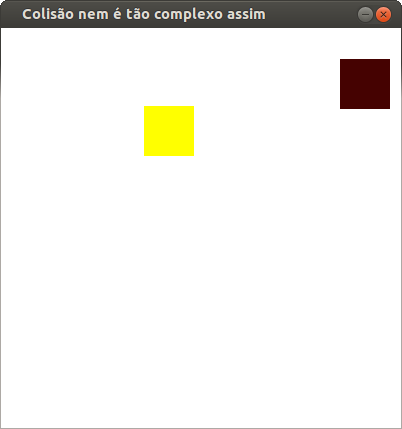Tutorial OpenGL v2.0
Finalmente chegou! Após quase 1 ano depois de meu primeiro artigo sobre OpenGL, chegou a versão 2.0. Clique e fique mais Geek.
[ Hits: 18.379 ]
Por: Thiago Henrique Hüpner em 08/05/2015
A jornada é longa parte 2 - Colisão entre 2 Retângulos
O exemplo ficou meio "tosco", mas tem como ter uma ideia de como funciona.
Aquele rolo de salvar e compilar você já sabe, então, vou pular essa parte:
#include <SDL/SDL.h>
#include <SDL/SDL_opengl.h>
#include <time.h>
#define LARGURA 400
#define ALTURA 400
int colisao(SDL_Rect a,SDL_Rect b){
if(a.x <= b.x+b.w && a.x+a.w >= b.x){
if(a.y <= b.y+b.h && a.y+a.h >= b.y){
return 1;
}
}
// Se passou pelos if's e não retornou significa que não houve colisao
return 0;
}
void inicializaOpenGL(){
glClearColor(255,255,255,1);
glMatrixMode(GL_PROJECTION);
glLoadIdentity();
gluOrtho2D(0,LARGURA,ALTURA,0);
glMatrixMode(GL_MODELVIEW);
glClear(GL_COLOR_BUFFER_BIT);
}
// Simulando o SDL_FillRect
void GL_FillRect(SDL_Rect a,int r,int g,int b){
glLoadIdentity();
glColor3ub(r,g,b);
glBegin(GL_QUADS);
// Lado Superior Esquerdo
glVertex2f(a.x,a.y);
// Lado Superior Direito
glVertex2f(a.x+a.w,a.y);
// Lado Inferior Direito
glVertex2f(a.x+a.w,a.y+a.h);
// Lado Inferior Esquerdo
glVertex2f(a.x,a.y+a.h);
glEnd();
}
int main(int argc,char *argv[]){
if(SDL_Init(SDL_INIT_VIDEO) < 0){
// ... imprima a mensagem de erro e ...
printf("Erro : %s
",SDL_GetError());
return -1;
}
// Para sempre ter valores pseudo-aleatorios
srand((unsigned)time(NULL));
SDL_GL_SetAttribute( SDL_GL_RED_SIZE, 8 );
SDL_GL_SetAttribute( SDL_GL_GREEN_SIZE, 8 );
SDL_GL_SetAttribute( SDL_GL_BLUE_SIZE, 8 );
SDL_GL_SetAttribute( SDL_GL_ALPHA_SIZE, 8 );
SDL_GL_SetAttribute( SDL_GL_DOUBLEBUFFER, 2 );
SDL_Surface * tela = SDL_SetVideoMode(LARGURA,ALTURA,32,SDL_OPENGL);
if(tela == NULL){
printf("Erro : %s
",SDL_GetError());
SDL_Quit();
return -1;
}
SDL_WM_SetCaption("Colisão nem é tão complexo assim",NULL);
SDL_Event evento;
int estaRodando = 1;
SDL_Rect retangulo,r2;
inicializaOpenGL();
int r = 255;
int g = 0;
int b = 0;
int posX = 100;
int posY = 100;
int aux1 = 10;
int aux2 = 10;
while(estaRodando){
while(SDL_PollEvent(&evento)){
switch(evento.type){
case SDL_QUIT:
estaRodando = 0;
break;
case SDL_MOUSEMOTION:
posX = evento.motion.x;
posY = evento.motion.y;
if(colisao(retangulo,r2)){
// Muda a cor R,G e B e consequentemente a cor do retangulo muda
// NOTA : Tem que ser 256 e não 256 , pois a chance de ser 255 é muito pequena e usando o 256 , a chance aumenta
// de ser 255
r = rand() % 256;
g = rand() % 256;
b = rand() % 256;
// Posicao aleatoria
aux1 = rand() % (LARGURA - retangulo.w);
aux2 = rand() % (ALTURA - retangulo.h);
}
break;
default:
break;
}
}
retangulo.x = aux1;
retangulo.y = aux2;
retangulo.w = 50;
retangulo.h = 50;
r2.x = posX;
r2.y = posY;
r2.w = 50;
r2.h = 50;
// Desta vez limpo a tela aqui e não no GL_FillRect, pois pode haver conflito
//de um retangulo aparecer e outro não
glClear(GL_COLOR_BUFFER_BIT);
GL_FillRect(retangulo,r,g,b);
GL_FillRect(r2,255,255,0);
SDL_Delay(30);
SDL_GL_SwapBuffers();
}
SDL_Quit();
return 0;
}
Veja como ficou (após ter brincado um pouco...):

Ele troca a cor do retângulo (retângulo) colide com o segundo retângulo(r2), e o primeiro retângulo vai para um outro lugar da tela.
Mas como funciona a colisão?
Bom, vamos por partes.
Ele verifica primeiro se colidiu o eixo x com 2 verificações:
- a.x <= b.x+b.w[ate aki] && a.x+a.w >= b.x, ou com outras palavras , "A posição X do Retangulo A é Menor ou Igual a Posição X incrementada da Largura do Retangulo B"?
- a.x <= b.x+b.w && [italico]a.x+a.w >= b.x, ou com outras palavras, "O Retangulo A incrementado da Largura dele é maior ou igual a posição X do Retangulo B"?
É o mesmo conceito para o eixo y, mas utilizando a altura em vez de largura. Deixo como desafio, tentar fazer um joguinho simples de pegar retângulos caindo (tipo o "pega-maçã").
2. Inicializando o SDL
3. OpenGL e SDL botando pra quebrar
4. Simulando uma Gambiarra
5. A jornada é longa parte 1 - Colisão Mouse e Retângulo
6. A jornada é longa parte 2 - Colisão entre 2 Retângulos
7. "Imagine" seu programa
8. Agradecimentos, links úteis e fontes
Ubuntu/Debian/Kali Linux e outros no Android
Utilizando a biblioteca NCURSES - Parte II
Gerencie suas contas financeiras pessoais com Terminal Finances
Criando um sistema operacional com ASM e C++
Muito bom! Vou tentar criar um game simples pra minha filha ficar clicando no retângulo com a cor certa com base neste tutorial.
[1] Comentário enviado por fabio em 08/05/2015 - 10:30h
Muito bom! Vou tentar criar um game simples pra minha filha ficar clicando no retângulo com a cor certa com base neste tutorial.
Fábio, mais uma vez, muito obrigado !
E boa sorte com o aplicativo, espero que sua filha goste.
Qualquer dúvida só pedir =D
[]'s
T+
Bom artigo!
Favoritado e pega meu 10!
Até
[3] Comentário enviado por UmCaraAToa em 08/05/2015 - 11:25h
Bom artigo!
Favoritado e pega meu 10!
Até
Valeu fera
T+
Favoritado. Vou ler depois com calma. Mas só de dar uma olhada por rápida vi que é material interessante!
--
http://pastebin.com/aji5Qp05
[5] Comentário enviado por xerxeslins em 08/05/2015 - 11:49h
Favoritado. Vou ler depois com calma. Mas só de dar uma olhada por rápida vi que é material interessante!
--
http://pastebin.com/aji5Qp05
Valeu fera, Obrigado!
[]'s
T+
Parabéns pelo artigo escrito, é uns dos melhores (e únicos) artigos sobre OpenGL aqui no VOL.
[7] Comentário enviado por preroeb em 08/05/2015 - 19:02h
Parabéns pelo artigo escrito, é uns dos melhores (e únicos) artigos sobre OpenGL aqui no VOL.
Valew pela força!
Dando duro pra trazer um artigo de qualidade pra vocês, meu povinho do "Volzinho"!
[]'s
T+
Ae Parabéns brother excelente artigo , favoritado aqui tbm :)
Igor Felipe
Cadastrado desde: 25/09/2009
[b]If it moves , compile it.[/b]
[9] Comentário enviado por Felipeigor em 08/05/2015 - 19:43h
Ae Parabéns brother excelente artigo , favoritado aqui tbm :)
Igor Felipe
Cadastrado desde: 25/09/2009
[b]If it moves , compile it.[/b]
Valew Tambem pelo apoio!
[]'s
T+
Legal cara, bem explicada a parte sobre colisão. Um bom artigo como um todo. Parabéns.
[11] Comentário enviado por SamL em 09/05/2015 - 12:50h
Legal cara, bem explicada a parte sobre colisão. Um bom artigo como um todo. Parabéns.
Valew Sam! Sempre me apoiando!
[]'s
T+
Oi, Thiago!
Dei uma rápida lida no seu artigo.
Está muito bom!
Continue assim, com essas ótimas contribuições!
Ang,
Manaus, AM, Brasil.
Usuário de sistemas operacionais livres/abertos tipo Unix ou tipo DOS,
Distros Favoritas: FreeBSD, Free-DOS, , PC-DOS, Bodhi Linux, Ubuntu, Big Linux, Kurumim, OpenSUSE, Slackware e Slax.
[13] Comentário enviado por Ang em 09/05/2015 - 16:14h
Oi, Thiago!
Dei uma rápida lida no seu artigo.
Está muito bom!
Continue assim, com essas ótimas contribuições!
Ang,
Manaus, AM, Brasil.
Usuário de sistemas operacionais livres/abertos tipo Unix ou tipo DOS,
Distros Favoritas: FreeBSD, Free-DOS, , PC-DOS, Bodhi Linux, Ubuntu, Big Linux, Kurumim, OpenSUSE, Slackware e Slax.
Valew !
Obrigado por ter lido!
[]'s
T+
Patrocínio
Destaques
Artigos
Passkeys: A Evolução da Autenticação Digital
Instalação de distro Linux em computadores, netbooks, etc, em rede com o Clonezilla
Título: Descobrindo o IP externo da VPN no Linux
Armazenando a senha de sua carteira Bitcoin de forma segura no Linux
Enviar mensagem ao usuário trabalhando com as opções do php.ini
Dicas
Instalando Brave Browser no Linux Mint 22
vídeo pra quem quer saber como funciona Proteção de Memória:
Encontre seus arquivos facilmente com o Drill
Mouse Logitech MX Ergo Advanced Wireless Trackball no Linux
Compartilhamento de Rede com samba em modo Público/Anônimo de forma simples, rápido e fácil
Tópicos
VMs e Interfaces de Rede desapareceram (12)
Instalação do drive do adaptador wiffi (7)
Top 10 do mês
-

Xerxes
1° lugar - 74.568 pts -

Fábio Berbert de Paula
2° lugar - 54.738 pts -

Mauricio Ferrari
3° lugar - 17.012 pts -

Andre (pinduvoz)
4° lugar - 15.718 pts -

Alberto Federman Neto.
5° lugar - 15.514 pts -

Daniel Lara Souza
6° lugar - 15.130 pts -

Diego Mendes Rodrigues
7° lugar - 14.805 pts -

Buckminster
8° lugar - 13.620 pts -

edps
9° lugar - 12.511 pts -

Alessandro de Oliveira Faria (A.K.A. CABELO)
10° lugar - 11.864 pts




